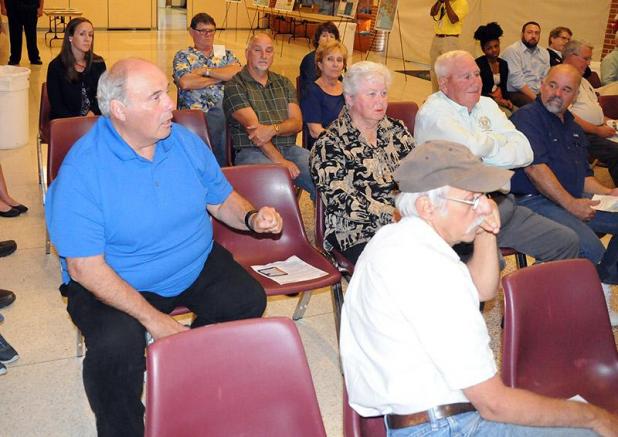
Morgan City Councilman Louis Tamporello speaks during Wednesday’s South Central Coastal Louisiana Flood Risk Management Study meeting at the Morgan City Municipal Auditorium. (The Daily Review/Zachary Fitzgerald)
River flood discussed at storm risk meeting
Storms are often a big concern for south Louisiana residents, but backwater riverine flooding is at the forefront of many Morgan City-area residents’ minds right now.
The U.S. Army Corps of Engineers, New Orleans District hosted a public meeting Wednesday at the Morgan City Municipal Auditorium. The meeting’s purpose was to get public input on the South Central Coastal Louisiana Flood Risk Management Study, which is intended to investigate hurricane protection and storm damage risk reduction opportunities in St. Mary, St. Martin and Iberia parishes.
Wednesday’s meeting coincidentally occurred at a time when flooding of a different type is happening as the Atchafalaya River is at a high stage and causing backwater flooding, especially in lower St. Martin Parish. The National Weather Service predicts the river will crest near 8.2 feet Sunday in Morgan City. The Atchafalaya has been above the 6-foot flood stage since January.
Carrie Schott, project manager for the study, said the Corps is partnering on the federally funded $3 million, three-year study with the Louisiana Coastal Protection and Restoration Authority as the nonfederal sponsor along with other entities.
The Corps’ No. 1 priority is to enhance public safety in these three parishes. Officials also want to reduce flood risk to critical infrastructure and the key evacuation route on U.S. 90, said Karla Sparks, the study’s lead planner.
Morgan City Councilman Louis Tamporello said that though U.S. 90 is a key route, La. 70 is another vital evacuation route, which currently has sections under water in the Stephensville area of lower St. Martin Parish.
“We need protection from hurricanes. Thank God we haven’t had a hurricane every year,” Tamporello said.
However, riverine flooding is becoming more frequent, having been an issue in the region each year since 2016, he said.
“We’ve had water on the levees for over seven months,” he said.
Officials have done a great job helping secure funds to construct a permanent floodgate on Bayou Chene that will protect parts of St. Mary, lower St. Martin and four other parishes from backwater flooding, Tamporello said.
In addition to hurricane protection funds, the area needs help now to stop the riverine flooding that seems to be becoming an annual event, he said.
Corps spokesman Matt Roe said Tamporello’s comments are the type of information study leaders need to better understand the area’s issues.
Organizers initiated the study in November 2018 and have formulated a tentatively selected plan. But they are now considering and open to exploring alternative plans, Schott said. An alternative plan will be selected and presented in December 2019 or January 2020. By September 2021, organizers expect to submit a final report for the study.
Corps officials recognize that they need to examine areas outside of the three parishes to better understand from where the water is coming and consider mitigation bank availability within the study area, Sparks said.
St. Mary Parish Councilman Paul Naquin, a former parish president, said that if officials are going to implement hurricane or flood protection measures to save lives, they shouldn’t be required to buy expensive mitigation credits that can be cost-prohibitive to providing protection.
An initial public meeting last year identified potential problems and solutions for the South Central study. Project leaders were required to forecast the most likely future scenarios that could occur within the next 50 years based on different plans of action, Sparks said.
Based on public feedback at the start of the study, problems in the area include storm surge as well as riverine flooding. Existing levees in the study area mostly on the eastern side were designed for riverine flooding. The levees also provide some storm surge protection but not 1% hurricane protection, Sparks said.
If officials take no action during the next 50 years, they predict an increased flood risk related to sea level rise, more storm surge and more storm damages based on higher storm frequencies and intensities. The Wax Lake Outlet Delta would continue forming at its current rate, she said.
Project organizers are considering two conceptual levee alignments that would include drainage pumps at canals and gates at bridges. One alignment would follow U.S. 90 trying to protect that evacuation route, while the other alignment would be below the highway.
Officials are looking at possibly raising levees on the study area’s eastern side to the 1% hurricane protection level and building ring levees around damage “hot spots,” Sparks said.
Non-structural measures project officials are considering include elevating homes, flood-proofing industrial properties, relocating high-risk structures and placing storm surge barriers along the coast.
Comments on the study can be provided to: Carrie Schott CEMVN–PM–B U.S. Army Corps of Engineers New Orleans District, 7400 Leake Avenue, New Orleans, LA 70118 or by e-mail to Southcentralcoaststudy@ usace.army.mil.
